Whether you’re a serious athlete or just want to add some cool new tricks to your repertoire, plyometric exercises are the key to increasing your power, improving your reaction time, and taking your athleticism to the next level.
Here are seven plyo exercises to help you build power quickly:
Whether you’re a serious athlete or just want to add some cool new tricks to your repertoire, plyometric exercises are the key to increasing your power, improving your reaction time, and taking your athleticism to the next level.
Here are seven plyo exercises to help you build power quickly:
1. Box Jumps
Simple box jumps are an awesome addition to any exercise routine. Performed correctly, they build power and increase your speed and agility, not to mention get your heart rate up without ever stepping on a treadmill.
To do them, you’ll need a plyo box, soft box, or a sturdy elevated surface. Beginners should start with a lower box, as the higher the plyo box, the more difficult this exercise will be.
Do this:
- Stand in front of a plyo box with your feet approximately shoulder-width apart.
- Jump forward and up onto the box, landing with your knees slightly bent.
- Step back down before repeating the jump.
To make box jumps more difficult, you can work on stringing them together rather than breaking them up as described above.
Do this:
- Stand in front of a plyo box with your feet approximately shoulder-width apart.
- Jump onto the box, then jump (or step) back down to the starting point.
- Briefly absorb the shock of the jump, then jump immediately back onto the box without resting.
2. Lateral Jumps
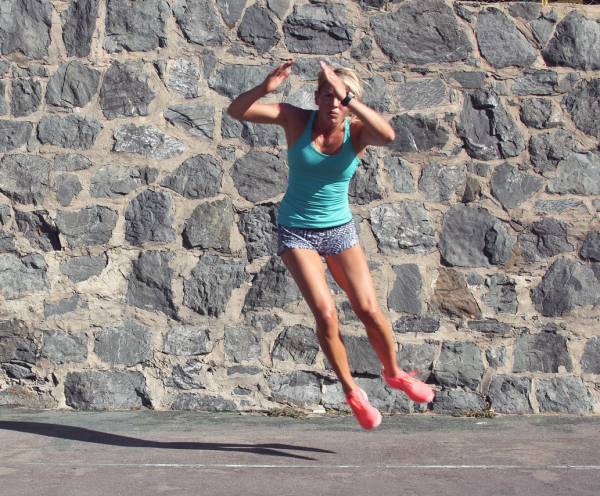
Lateral jumps will increase your lateral power and speed. They are an essential exercise for any athlete who needs to switch directions quickly.
Do this:
- Stand with your feet about shoulder width apart.
- Jump as high and far as you can to one side.
- Immediately jump back to the starting place.
Get creative with lateral jumps and make them harder by adding an obstacle to jump over. The higher the obstacle, the more difficult the jumps will become.
3. Depth Jumps
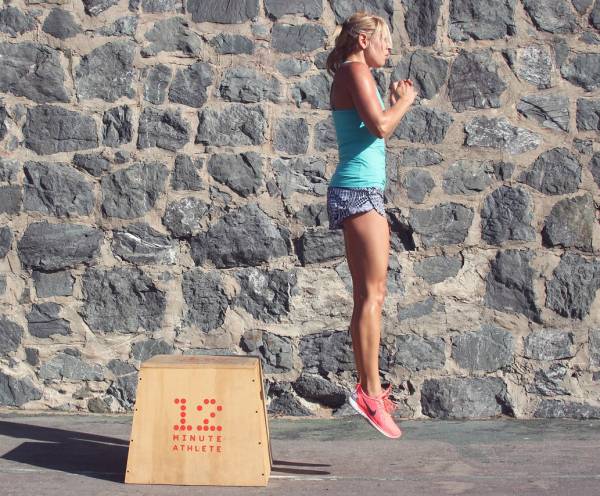
Depth jumps are a phenomenal exercise to build power and increase your vertical leap. Performing depth jumps from lower plyo boxes (around 30”) will lead to the greatest explosive strength and reaction gains, while performing them from higher plyo boxes (around 42”) will lead to the greatest strength development.
Do this:
- Stand on top of a plyo box with your feet about shoulder width apart.
- Step off the box, bending your knees to absorb the shock as you land.
- Immediately jump up as high as you can.
4. Plyo Push Ups
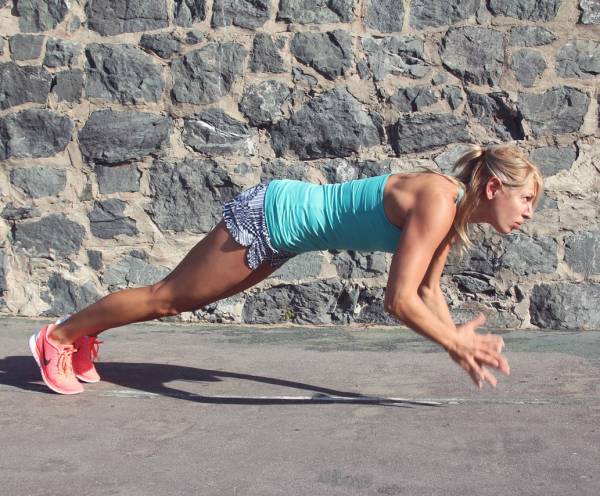
To build explosive upper body strength and power, there’s no exercise better than plyo push ups. There are tons of different variations of the plyo push up. Try some of these advanced variations to mix up your training:
Plyo Clap Push Ups
Do this:
- Get in a push up position with your hands directly underneath your shoulders.
- Bend your elbows so that your chest is a few inches above the floor.
- Push up explosively, clapping your hands as you reach the top position before landing back in a push up.
Full Body Explosive Push Ups
Do this:
- Get in a push up position with your hands directly underneath your shoulders.
- Bend your elbows so that your chest is a few inches above the floor.
- Push up explosively with your entire body so that both your hands and feet leave the floor.
Push Up Onto Higher Surface
Do this:
- Get in a push up position with your hands directly underneath your shoulders.
- Bend your elbows so that your chest is a few inches above the floor.
- Explode up as you push yourself up and forward onto a mat, yoga blocks, or a higher surface.
The more explosive you become, the higher surfaces you can jump onto.
The options for plyo push ups are endless. Be creative, have fun, and work on pushing your body higher and higher up in the air.
5. Long Jumps
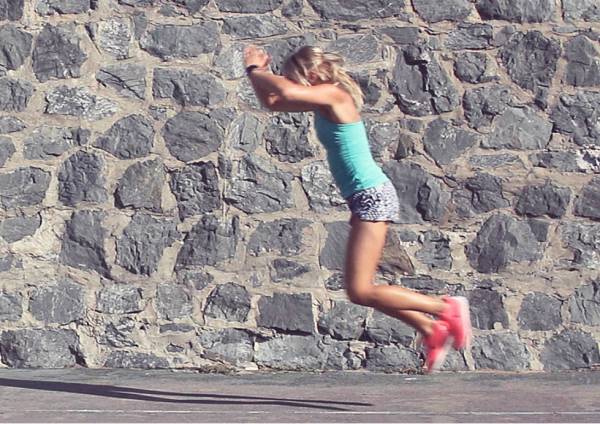
Long jumps are a classic power building and conditioning exercise. They will strengthen your legs and increase reaction time.
Do this:
- Stand with your feet about shoulder-width apart.
- Bend your knees, then jump as far forward as possible.
- Absorb the shock immediately, then take off into your next jump.
To make long jumps even more challenging, add obstacles to jump over in between jumps.
6. Single Leg Long Jumps
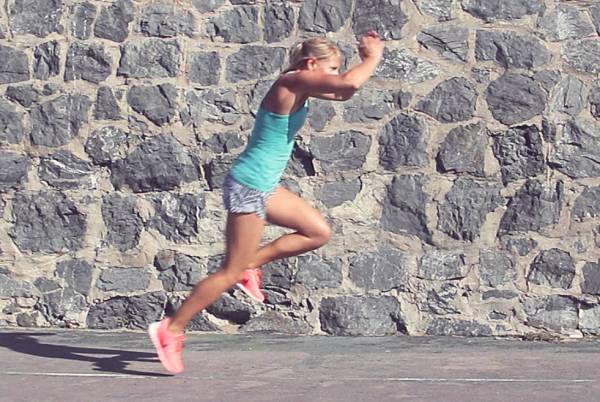
Single leg long jumps make long jumps even harder and build single leg explosiveness. As a bonus, they also force you to work on your single leg balance and coordination.
Do this:
- Stand up straight while holding one leg off of the ground.
- Squat down and jump as far forward as you can on one leg, pumping your arms as you do so.
- Try to go as fast as you can while still maintaining your balance.
Just like with regular long jumps, adding obstacles will increase the difficulty of single leg long jumps even more.
7. Jump Lunges
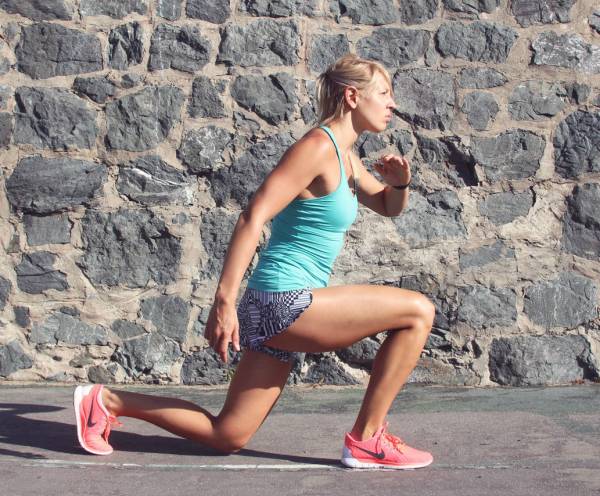
Jump lunges build single leg coordination and power and should be a staple in any power athlete’s exercise routine.
Do this:
- Start in a lunge position with one leg bent forward in a ninety degree angle and the other bent behind you.
- Jump up explosively with your back leg, then switch positions in the air and land with the opposite leg forward.
To make jump lunges even harder, place your back foot on a raised surface such as a mat or bench as you perform the exercise.
Keep Challenging Yourself
Whether your goal is to excel at a sport or to conquer some personal ambitions, increasing power and reaction time with plyometric exercises is a must for any athlete. You can try adding them to your workout routine in different ways:
- Use them to work on improving individual skills. Paying special attention to your technique and form, particularly when you’re new to the movement, will help you master the exercise and prevent future injuries. Box jumps and depth jumps specifically should be treated with due care.
- Add them to a circuit or HIIT workout. This will help you maximize your workout efficiency by elevating your heart rate and improving your conditioning as you work to increase power.
- Add them to a mini-circuit workout finisher at the end of your regular skill practice. This will help use up any remaining energy at the end of a workout without taking too much extra time.
Just as with any new skill or exercise, the key to hitting your goals is to work these exercises consistently and keep pushing yourself to avoid plateaus. As you get better and stronger at the movements, get creative and add obstacles to keep yourself challenged and reaching new heights – literally.
More Like This
- Proper Plyometrics: How to Box Jump, Vertical Jump, and Broad Jump Correctly
- 7 Best Bodyweight Exercises for Stronger Legs
- 3 Ways to Build Lean Muscle With Bodyweight Exercise
Photos courtesy of Krista Stryker.






